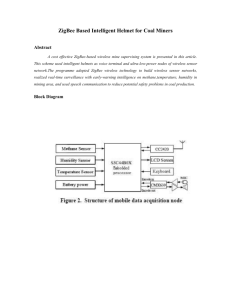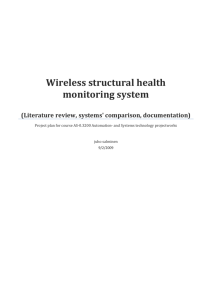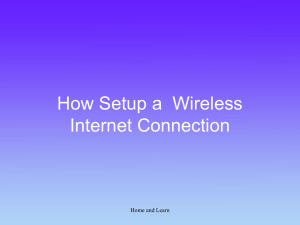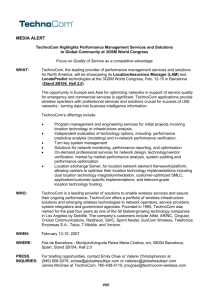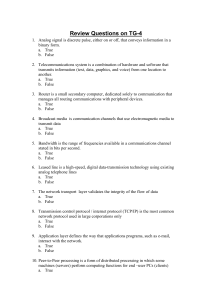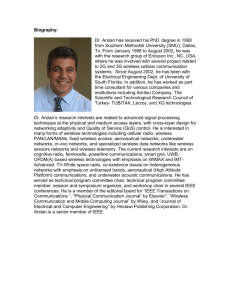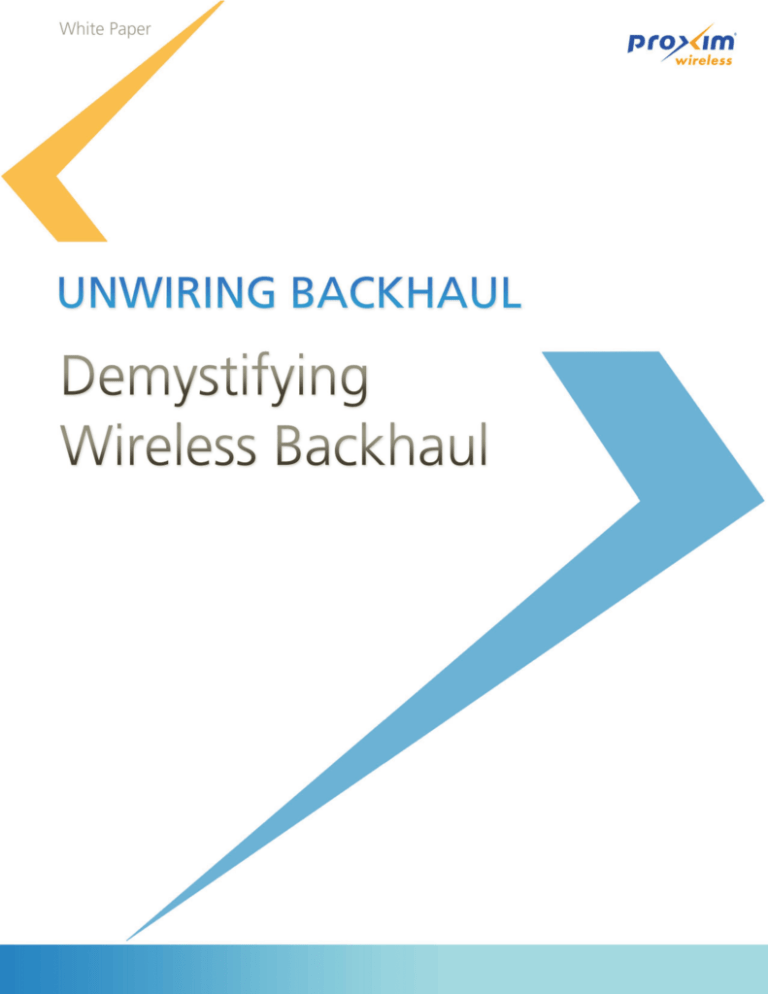
White Paper - Unwiring Backhaul
©2012
©2010 All rights reserved. Proxim Wireless Corporation.
Corporation
1
White Paper - Unwiring Backhaul
Organizations such as ISPs, carriers, medical facilities, and others
that extend across multiple, geographically dispersed locations demand secure, scalable, and cost-effective interconnected networks.
A wireless network solution is often the “best-fit “for these applications.
What is Backhauling?
Backhaul or Backhauling, a term derived from the trucking industry,
defined as cargo carried on a return journey or shipment sent on
Why Wireless?
Wireless has many benefits. To list down a few:
Secure: Contrary to popular belief, today’s wireless communications utilize several advanced encryption algorithms that ensure secure information exchange.
Scalable: Modern, sophisticated wireless devices are designed to
quickly and easily expand to new locations.
a returning vehicle, has several usages in the Telecommunications
Cost-efficient: By avoiding the capital expense of laying fiber and
field.
the operational expense of maintaining it, wireless communications
•
•
In the context of broadcasting, backhaul refers to uncut pro-
proves to be far more cost-effective.
gram content transmitted point-to-point to an individual sta-
Reliable: The latest wireless solutions are extremely reliable and
tion, where it is integrated into a completed TV show.
provide uptime / availability of 99.99% and more.
In satellite technology, it means to transmit data to a point
High Performance: With the advent of latest technologies, wire-
from which it can be distributed over a network or uplinked
less solutions can provide throughput in excess of 4G speeds.
to a satellite.
•
In the networking industry, it simply means to transmit data to
the network backbone or, in some instances, to communicate
between two devices also referred to as a “point-to-point”
connection, commonly referred as P2P or PtP.
Please refer to a couple of typical wireless backhauling deployments
on page 3
©2012 All rights reserved. Proxim Wireless Corporation.
2
White Paper - Unwiring Backhaul
Point-to-Point Communication
Network Backhauling
©2012 All rights reserved. Proxim Wireless Corporation.
3
White Paper - Unwiring Backhaul
Communication Mediums of Backhauling
Wireless
Fiber optic
The medium used to communicate wirelessly between devices is
Technology that makes use of light to transmit data. The optical
fiber consists of a core, which carries the light. This core is clad to
prevent leakage. There are further layers, such as a resin layer and
a plastic jacket that add strength to the cable. Fiber for backhaul
or Point-to-Point applications are expensive due to trenching and
installation costs.
radio frequency (RF). An RF signal begins as an electrical alternating current (AC) signal generated by a transmitter. This AC signal is
sent through a cable and radiated out of an antenna in the form of
an electromagnetic wireless signal. Changes in electron flow in an
antenna, otherwise known as current, produce changes in the electromagnetic fields around the antenna. At the other end, another
antenna receives the signals. Once received by the antenna, it is
passed to the receiver in the form of electrical signals.
Optical Fiber
Wireless Medium
Ethernet Cables
Myths and Facts of Wireless Communications
The Ethernet (CAT 5) cable, capable of transmitting up to 1000
MYTH #1: Wireless communications are vulnerable to intrusion and
Mbps, consists of four pairs of wires. Each pair has a common color
attacks.
of twisted copper wires. Ethernet cable as a PtP solution is seldom
used due to high attenuation, susceptibility to interference and high
costs .
FACT: With the advances in wireless communications today there
are multiple solutions for transmitting data securely. The most widely used in the wireless space is AES -128 or Advanced Encryption
Standard, ratified by the National Institute of Standards and Technology. It is a secure, 128-bit key standard, which simply means
that it would take 2128
operations or 340,282,366,920,938,463,4
63,374,607,431,768,211,456 turns to decipher the message for an
unauthorized user, which is widely considered to be out of reach,
even for contemporary computing techniques.
MYTH #2: Wireless devices require line of sight to operate.
FACT: MIMO (Multiple In and Multiple Out) technology enables devices to communicate in conditions when line of sight is unavailable.
Ethernet Cable
©2012 All rights reserved. Proxim Wireless Corporation.
MIMO uses multiple receiving and transmitting antennas and lever-
4
White Paper - Unwiring Backhaul
ages the reflected signals of multipath as opposed to eliminating
them. Another benefit of using MIMO is high throughput.
MYTH #3: Wireless backhaul is incompatible with existing backhaul.
Scalability
Fiber must be handled with great care while installing in rough rural
terrains as well as highly urbanized areas.
To sum up one of the biggest disadvantages of fiber optic systems
FACT: Wireless backhaul technology allows seamless integration of
is that the RoI is quite low due to recurring maintenance cost and
wired backhaul networks with the newly deployed advanced wire-
inflexibility
less backhaul points, resulting in a complete hybrid model.
MYTH #4: High Capital Expenditure and low ROI are associated
with wireless solutions.
FACT: Wireless offers the most cost-effective solution with LOW
Capital Expenditure available today. A wireless solution eliminates
the high cost of trenching and laying cable between Points of Presence (PoPs), resulting in a rapid and high return on investment.
How to Choose a Wireless Solution?
Selecting Your Backhaul Solution
Selecting the right backhaul solution is a balance of speed, distance,
and price. For wireless technologies, a rule of thumb is the faster
and longer the coverage, the more expensive it is going to be. Also
keep in mind future demand when selecting a solution.
Here are a few frequently asked questions that should be consid-
Wireless Versus Wired Backhaul
Exponential growth in cell phone subscribers, in combination with
the availability of mobile data devices such as 3G handsets, laptop
cards and PDAs, have driven the demand for data, voice, video and
ered when looking into a backhaul communication solution:
What frequency ranges and power levels are acceptable in my
country?
multimedia services. To address to this demand, existing backhaul
Different countries and geographies have different policies on the
networks need to continuously upgrade. However the process of
frequency ranges and the power labels. It is imperative that the pur-
upgrading traditional wired backhaul systems presents two major
chaser be aware of the regional variations in radio communications
barriers to service providers:
standards and regulations.
High Capital Expenditure and Operational Expenditure
Is the radio easily programmable for both frequency and pow-
•
Installation of fiber, most cost-effective solution whether on
pole or underground, includes expensive trenching costs.
•
Optical transmitters and receivers, as well as fiber splicing, are
required every six kilometers, resulting in heavy capital cost
•
Fiber cables also have high, recurring maintenance and lease
costs
er?
Many radios on the market today do not meet local country regulations due either to transmitting too much power or to frequencies
not approved for unlicensed use. Therefore, it is important to determine whether or not the radio can be programmed to meet these
regulations.
Factors
Wireless Backhaul
Wired Backhaul
Cost
Low cost of installation and maintenance
High cost of installation and maintenance
Installation
Easy and quick installation process
Time-consuming process of trenching and laying fiber
Scalability
Completely scalable, can be installed easily in any terrain
Scalability a major limitation in rural/remote areas, as well as
in densely populated metro environments
Service Time
The turnaround time to either service or repair the network In case of any downtime the complete fiber line has to be
would only involve replacing the faulty devices
checked for any cuts
Manageability Devices performance can be viewed from a centralized No centralized management available
point
©2012 All rights reserved. Proxim Wireless Corporation.
5
White Paper - Unwiring Backhaul
Should I use a licensed or un-licensed band?
Unlicensed links can be up and running in a comparatively short
time and without a lot of added expense to the end user. The short-
Yagi Antennas: Are essentially used for small- to medium-distance
coverage, however, high-gain Yagi antennas are available to provide higher distance coverage.
coming is potential interference. With unlicensed radios, the end
A few best practices to consider before implementing a point-to-
user has no control over who is able to use the frequency and, thus,
point backhaul solution:
can encounter unexpected interference. However, if precautions are
•
Hire a good outdoor wireless integrator
years.
•
Understand the solution before choosing the system
Licensed links, on the other hand, tend to have higher through-
•
Know the wireless equipment you are buying
•
Choose proven and field-tested wireless backhaul systems
•
Have a professional wireless installer to do It right
taken, one can use an unlicensed link successfully for a number of
puts and be more reliable. Because the frequency is licensed, users
are certain they’re the only ones allowed to use that frequency.
They also have confidence that an occasional access point within a
residential or business area will not cause downtime or slow their
network. Licensed links are generally more expensive because of
licensing fees and the additional time needed to install the system.
What type of antenna do I need?
Various types of antennas are available, built with specific purposes.
For point to point antennas, there are generally two categories:
Semi-Directional: Using the analogy of a study table lamp that
concentrates on a certain area, semi-directional antennas focus on
a pie-shaped area.
Highly Directional: Directional antennas are more narrowly focused like a laser pen used for presentations and are used only for
point-to-point communications.
The types of antennas are as follows:
Parabolic Antennas: Consist of a parabolic shaped dish and an
antenna located in front of the dish. Due to the parabolic shape, the
antenna concentrates radiation into a narrow pattern, producing a
high-gain beam.
Grid Antennas: Are similar to a grill slightly curved inwards and are
highly directional antennas. The grill lets the wind pass through and
leaves the antenna direction undisturbed.
Panel Antennas: Fall under the semi-directional antenna category,
consisting of a rectangular pane enclosure, is extremely rugged and
easy to install.
Patch Antennas: Can be mounted on a flat surface or a wall. They
consist of a patch of metal placed on a sheet of metal usually contained inside a plastic enclosure. They are also known as rectangular
micro strip antennas.
©2012 All rights reserved. Proxim Wireless Corporation.
6
White Paper - Unwiring Backhaul
Applications
There are many wireless backhaul solutions to meet the needs of all kinds of organizations. A few scenarios for optimized wireless backhaul
in real-time applications are illustrated below.
Backhaul to a Central POP
For POPs located in remote areas, backhauling to central POP via Fiber can be expensive and time consuming. Below are shown two remote
POPs connected wirelessly to a central POP that avoid the huge cost of laying fiber, enabling rapid scaling in remote locations.
Leased-line Redundancy / Inter-POP Redundancy
Avoid downtime caused by a wire line backhaul failure by adding a QuickBridge link as an inter-POP redundancy
Fibers or cables run a constant risk of being cut or clipped due to weather, construction, and other causes that can lead to a significant outage.
This risk can be avoided by adding a wireless solution to the wire line, strengthening the connection against conditions like construction and
weather and reducing downtime, ultimately leading to higher productivity.
©2012 All rights reserved. Proxim Wireless Corporation.
7
White Paper - Unwiring Backhaul
Repeater
Any communication signal over any medium, whether wireless or wired, gradually looses intensity (i.e., attenuates) as it travels over long
distances. This can be overcome by installing repeaters that receive the diminished signal and retransmit it at a higher level / higher power to
cover longer distances. Below is a typical scenario of wireless PtP devices functioning as repeaters.
Building-to-Building Connectivity
Organizations ranging from hospitals with several departments to enterprises spread over multiple locations must be able to communicate
with each other constantly and with critical applications, such as ERP or Managmement Information Systems. This requires secure, scalable,
and high-performance communication solutions. Relying on wired connectivity only adds to complexity and high CapEx.
Connecting buildings and campuses via wireless backhaul is much easier to deploy and far more cost-effective. Surveillance monitoring can
also be implemented between the main office and branch locations for security services. Mobility, along with the flexibility for easy structural
expansion of connected services and low capital costs is driving the wireless demand for building-to-building applications.
©2012 All rights reserved. Proxim Wireless Corporation.
8
White Paper - Unwiring Backhaul
Wireless Backhaul in Action
The Aqaba Water Company
Campus Wide Connectivity-UNACH
Challenge:
Challenge:
•
AWC needed to connect every well throughout their entire sys-
•
tem
•
high-availability broadband connectivity to support Virtual University, distance education
Given the number of components that needed to be connected, wired solutions were cost prohibitive and would take far
•
longer to deploy
•
net
•
and reliability
Solutions:
•
Widespread Proxim PtMP and PtP deployment throughout the
The first phase of the wireless SCADA deployment utilized
Solutions:
•
•
•
Results:
•
•
Proxim’s PtMP and PtP wireless equipment successfully con-
•
Proxim Tsunami® .GX Series – Carrier-class, long-range wireless
Ethernet bridge for voice and data backhaul
•
Proxim ORiNOCO® AP-8000/4000
Results:
•
All 11 campus facilities of UNAC are connected creating “Red
nects AWC’s water wells to a centralized supervisory control
UNACH, CERO MAYA,” a cutting-edge information and wire-
and data acquisition (SCADA) network
less communication network providing access to distance learn-
Initial savings of over 300,000 JD (more than $422,000 USD) in
ing, digital education tools and the Internet
up-front capital cost over wired solutions
•
Proxim Tsunami® QB-8100 – High-speed, carrier-grade pointto-point wireless backhaul with NLOS capabilities
The entire system is managed centrally by the ProximVision ES
Wireless Network Management System
Proxim Tsunami® QuickBridge – Quick, easy-to-install point-topoint wireless backhaul that provides a complete hop in a box
Proxim’s Tsunami® MP.11 PtMP and Tsunami QuickBridge®
PtP solutions
Cost–effective solutions needed to provide support for voice,
data and video
entire Aqaba region
•
6 of 9 campuses lacked any form of broadband connectivity
and were unable to access digital education tools or the Inter-
As it connected the wells to the central SCADA network, this
was a mission-critical network that required high performance
Universidad Autónoma de Chiapas required high bandwidth,
•
Proxim’s wireless solutions cost-effectively delivered voice, data
and video connectivity along with management tools to previ-
Annual savings of 15,000 JD (over $21,000 USD) by avoiding
ously isolated campus locations
leased-line costs
•
UNAC is now able to extend administrative support to all its
campuses as well as providing the opportunity for connectivity to other entities such as health, security and educational
organizations
©2012 All rights reserved. Proxim Wireless Corporation.
9
White Paper - Unwiring Backhaul
Products
Tsunami® QB-8200 Series
ity, supporting an array of user configurable channel bandwidths
from 7-56 MHz. The product has an extremely small foot print and
comes in a split-mount design consisting of a compact indoor unit
(IDU) and outdoor unit (ODU) that are a snap to install. The GX800
licensed Point-to-Point products are technically advanced, highly
reliable and very cost effective.
Tsunami® QB-62000
The Tsunami® QB-8200, is a high power,extremely reliable and a
cost-effective, non-line-ofsight 4G point-to-point (PtP) wireless
backhaul solution. The Tsunami® QB-8200 delivers data rates of
300 Mbps plus, along with excellent spectrum flexibility of upto
1MHz channel spacing and high power radios capable of 27 dBm Tx
power for extend coverage. With its incredible channel capacity &
flexibility, excellent spectrum efficiency and a highly evolved prioritization platform ,the Tsunami® QB-8200 satisfies carriers, wireless
service providers and government organizations.
Tsunami® QB-8100 Series
Presenting a multi Gigabit wireless backhaul solution that exceeds
4G speed requirements in a package that is the smallest in the industry. The Tsunami® QB-62000 is a high capacity, extremely reliable and cost-effective, Point-toPoint (PtP) wireless backhaul solution. The Tsunami® QB-62000 delivers data rates of 1Gbps full
Duplex for a total of 2Gbps. The Tsunami® QB-62000 comes in an
all ODU package that is the smallest in the market at 7x7 inches.
Coupled with the widespread availability around the globe due to
its use of the license exempt 60GHz band, this means the Tsunami®
QB-62000 can be deployed almost anywhere within hours.
The Tsunami® QB-8100, an incredibly cost-effective, high-perfor-
Tsunami® QB.11 Series
mance and non-line-of-sight 4G point-to-point (PtP) wireless backhaul solution. With 300Mbps data rates in a complete “Hop-in-aBox” solution, deployments in networks of all sizes will enjoy a quick
return on investment. Leveraging the advantages of OFDM and the
latest MIMO radio innovations, the Tsunami® QB-8100 draws on
Proxim’s proprietary Wireless Outdoor Router Protocol (WORP) to
deliver wireless performance in excess of 4G products on the markets today.
®
Tsunami GX 800
The Tsunami® QuickBridge.11 family operates in the unlicensed frequency spectrums of 2.4 GHz and 5 GHz (5.15 to 5.95 inclusive
(and to 6.08 GHz with LR)) and comes complete with a set of accessories to ease outdoor installations. As the most cost-effective
point-to-point solution from Proxim, any deployment will enjoy a
quick return on investment.
Tsunami® GX800 is a high-speed, Point-to-Point (PtP) licensed
microwave product capable of operating in 6–38* GHz licensed
bands with more than 600Mbps aggregate throughput capac-
©2012 All rights reserved. Proxim Wireless Corporation.
10
White Paper - Unwiring Backhaul
About Proxim
Proxim Wireless Corporation (OTC Markets: PRXM) provides Wi-Fi®, Point-to-Point and Point-to-Multipoint 4G wireless network
technologies for wireless internet, video surveillance and backhaul applications. Our ORiNOCO® and Tsunami® product lines are
sold to service providers, governments and enterprises with over 2 million devices shipped to over 250,000 customers in over
65 countries worldwide. Proxim is ISO 9001-2008 certified. For more information, visit www.proxim.com. For investor relations
information, e-mail ir@proxim.com or call +1 413-584-1425.
Proxim and Tsunami are registered trademarks of Proxim Wireless Corporation in the US Patent and Trademark Office. All other
products or services are the property of their registered owners.
Proxim_WP_Unwiring-Backhaul
©2012 All rights reserved. Proxim Wireless Corporation.
www.proxim.com
Proxim Wireless Corporation
1561 Buckeye Drive, Milpitas
CA 95035, USA
11

